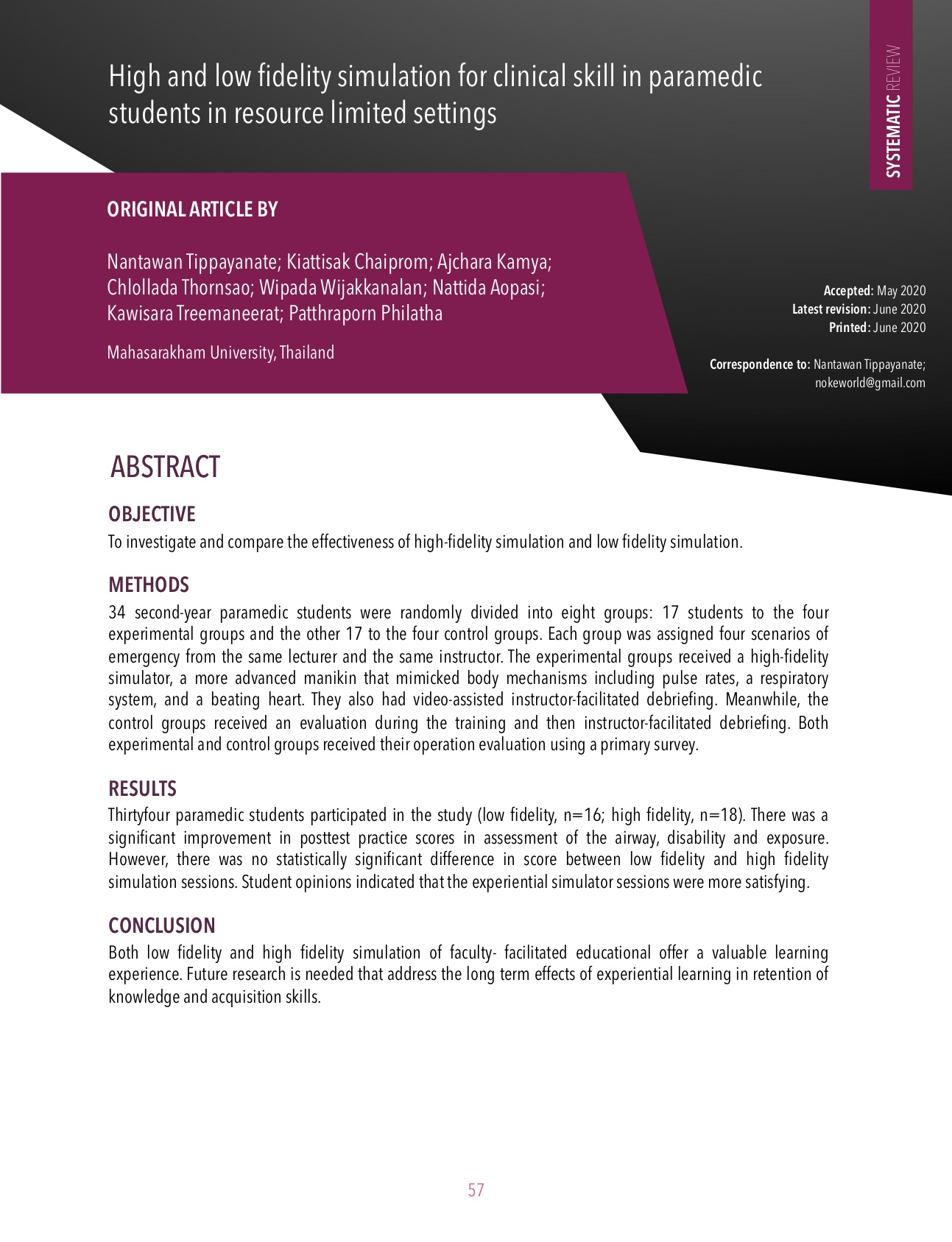High and low fidelity simulation for clinical skill in paramedic students in resource limited settings
คำสำคัญ:
high fidelity simulation, low fidelity simulation, paramedics, debriefing, life threatบทคัดย่อ
OBJECTIVE
To investigate and compare the effectiveness of high-fidelity simulation and low fidelity simulation.
METHODS
34 second-year paramedic students were randomly divided into eight groups: 17 students to the four experimental groups and the other 17 to the four control groups. Each group was assigned four scenarios of emergency from the same lecturer and the same instructor. The experimental groups received a high-fidelity simulator, a more advanced manikin that mimicked body mechanisms including pulse rates, a respiratory system, and a beating heart. They also had video-assisted instructor-facilitated debriefing. Meanwhile, the control groups received an evaluation during the training and then instructor-facilitated debriefing. Both experimental and control groups received their operation evaluation using a primary survey.
RESULTS
Thirtyfour paramedic students participated in the study (low fidelity, n=16; high fidelity, n=18). There was a significant improvement in posttest practice scores in assessment of the airway, disability and exposure. However, there was no statistically significant difference in score between low fidelity and high fidelity simulation sessions. Student opinions indicated that the experiential simulator sessions were more satisfying.
CONCLUSION
Both low fidelity and high fidelity simulation of faculty- facilitated educational offer a valuable learning experience. Future research is needed that address the long term effects of experiential learning in retention of knowledge and acquisition skills.
เอกสารอ้างอิง
A.L. Garden, D.M. Le. Fevre, H.L. Waddington, J.M. Weller. Debriefing after simulation-based non-technical skill training in healthcare: a systematic review of effective practice. Anesh Intensive Care 2015; 48:300-7.
Tracy Levette Jones, Samuel Lapkin. A systematic review of the effectiveness of simulation debriefing in health professional education. Nurse Education Today 2014; 34: 58-63.
Elena Tader. Clinical simulations for learning medical skills: a work-based approach to simulators. Procedia- Social and Behavioral Sciences 2015; 197: 2443-48.
Michael Green, Rayhan Tariq, and Parmis Green. Improving Patient Safety through Simulation Training in Anesthesiology: Where Are We?. Anesthesiology Research and Practice 2016: 1-12.
Christina Massoth, Hendrik Ohlenburg, and Michael Hessler. High-fidelity is not superior to low-fidelity simulation but leads to overconfidence in medical students. BMC Medical Education 2019: 2-8.
Fadi Munshi, Hani Lababidi, Sawsan Alyousef. Low- versus high-fidelity simulations in teaching and assessing clinical skills. Journal of Taibah University Medical Sciences 2015;10: 12-15.
A. Cheng, A. Lockey, F. Bhanji, Y. Lin, E. A. Hunt, and E. Lang. The use of high-fidelity manikins for advanced life support training—a systematic review and meta-analysis. Resuscitation 2015; 93: 142–9.
T.J. Olgers, R.S. Dijkstra, A.M. Drost- de Klerck, J.C. ter Maaten. The ABCDE primary assessment in the emergency department in medically ill patients: an observational pilot study. The Netherland Journal of Medicine 2017; 75: 106-12.
Jefferies PR. A framework for designing, implementing, and evaluating simulation used as teaching Strategies in nursing. NursEducPerspect 2005; 26: 96-103.
Karen A. Zapko, Mary Lou Gemma, Ferranto Rachel Blasiman and Debra Shelestak. Evaluating best educational practices, student satisfaction, and self-confidence in simulation: A descriptive study. Nurse Education Today 2018; 60: 28-34.
Rebecca D. Wilson, Mayo Clinic Hospital, Phoenix, Arizona James D. Klein. Design, implementation and Evaluation of a Nursing Simulation: A Design and Development Research Study. The Journal of Applied Instructional Design 2012; 2: 57-68.
V. Unver, T. Basak, P. Watts, V. Gaioso, J. Moss, S. Tastan, N. Tosun. The reliability and validity of three questionnaires: the “Student Satisfaction and Self-Confidence in Learning Scale”, “Simulation
Design Scale” and “Educational Practices Questionnaire”. Contemp. Nurse 2017; 53: 60-74.
G. Sherwood, J. Barnsteiner. Quality and Safety in Nursing: A Competency Approach to Improving Outcomes. Journal of Nursing Regulation 2012: 227-50.
Coolen EHAJ, Draaisma JMT, Hogeveen M, Antonius TAJ, Lommen CML, Loeffen JL. Effectiveness of high fidelity video-assisted real-time simulation: a comparison of three training methods for acute pediatric emergencies. Int J Pediatr 2012; 1-8.
Curran V, Fleet L, White S, et al. A randomized controlled study of manikin simulator fidelity on neonatal resuscitation program learning outcomes. Adv Health Sci Educ Theory Pract 2015;20:205–18.
King JM, Reising DL. Teaching advanced cardiac life support protocols: the effectiveness of static versus high-fidelity simulation. Nurse Educ 2011; 36: 62–5.
Fadi Munshi, Hani Lababidi, and Sawsan alyousef. Low- versus high-fidelity simulations in teaching and assessing clinical skills. Journal of Taibah University Medical sciences 2011;10: 12-15.
Cook DA, Hatala R, Brydges R, et al. Technology enhanced simulation for health professions education: a systematic review and meta-analysis. JAMA 2011; 3306: 978–88
Zulkosky, K.D. Simulation use in the classroom: impact on knowledge acquisition, satisfaction, and self-confidence. Clinical Simulation in Nursing 2012; 8: 25-33.
Randi Tosterud, Birgitta Hedelin, Marie Louise Hall-Lord. Nursing students’ perceptions of high- and low-fidelity simulation used as learning methods. Nurse education in practice 2011; 13:262-270.
T. Gore, C.W. Hunt, F. Parker, K.H. Raines. The effects of simulated clinical experiences on anxiety: nursing students' perspectives Clinical Simulation in Nursing 2010:1-6.



